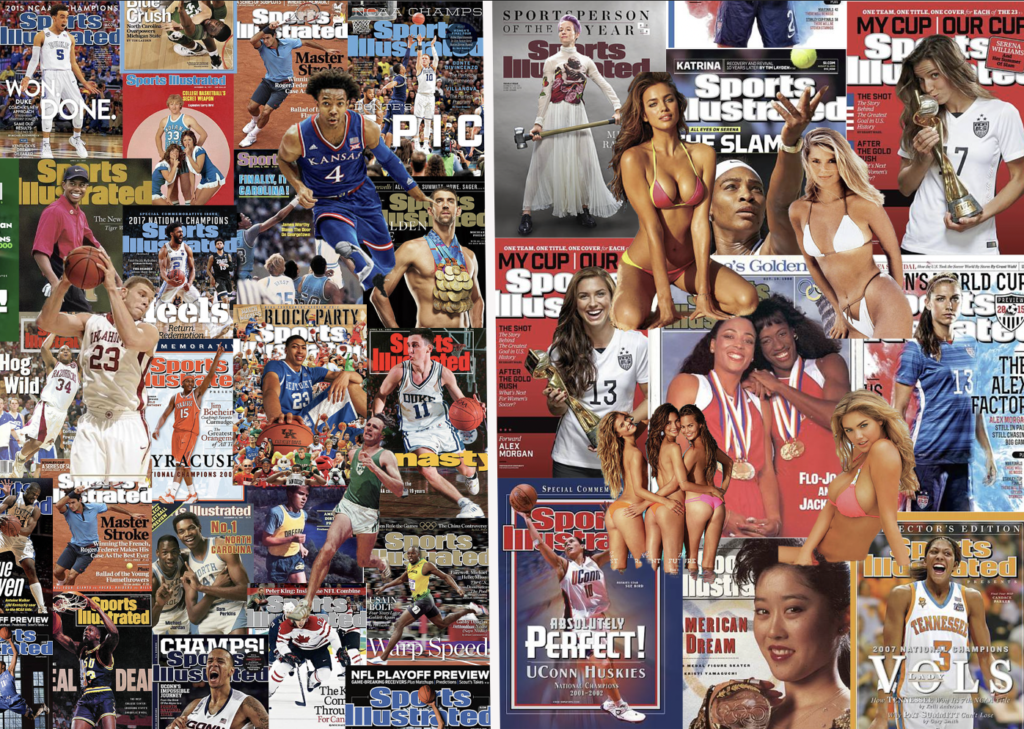
As hard as it is to believe, despite recent movements towards gender equality in sports, news coverage on woman peaked in the 1950s and has since decreased.1 When comparing recent Sports Illustrated covers featuring males versus females, there are many disparities. The covers of males typically show a male athlete, team, or coach being celebrated or in action on the court, field, or track.
Women, specifically female athletes, are constantly sexualized within media. In addition to the fact that women are severely underrepresented in sports magazines, such as Sports Illustrated, when they are shown on the cover, they are often in bathing suits and posed in sexually provocative positions. The representation on these covers conveys a message that their athletic accomplishments are incomparable to men, however, their sexuality gives them value. It displays the idea that a woman could not possibly be known or celebrated for only their athletic ability, their sexuality and their smile gives them value. From 2000-2011, women appeared on 4.9% of Sports Illustrated magazine covers.2 In addition, a study done in 2013 showed that only 2.5% of covers featured woman as the main subject, where most of the time, these covers are a part of the swimsuit edition.3 Their athletic ability is diminished through these sexual connotations and by doing this, a message is sent about female athletes. The covers featuring women show fewer action pictures, with their hair down and blown out, or are a part of the swimsuit edition. The Sports Illustrated swimsuit editions show models in bathing suits on the beach in provocative poses or topless, holding their breasts. Why are these images of women being included in a sports magazine?
This points to the harsh underrepresentation of females as decorated athletes and pins them as sexual athletes for men to admire. Along with men more likely to be shown in action, they are also more likely to have a more serious facial expression, where women can be found smiling on a majority of the covers. From 1954 to 2016, 61% of female athletes were photographed smiling compared to 28% of male athletes smiling.4 This indicates that if women were on the covers of magazines with stark facial expressions, shown in action, they would be too threatening to the male viewer.
In addition to the underrepresentation of female athletes on the covers of Sports Illustrated, there is a clear display of inequality when simply googling “sports illustrated.” The only female related quick link is the swimsuit edition, which is surrounded by two mens sports leagues and the NCAA College Basketball link which leads to stories about mens college basketball teams.
These sexualized images of female athletes perpetuate gender stereotypes of woman being objectified in the media. Specifically in the swimsuit editions, the portrayals of female athletes and woman as conventionally attractive further push the norm of heterosexuality. A study concluded that female athletes who don’t conform to hetersexual attractiveness norms receive less endorsements and audience approval.5 Rather than depicting female athletes as strong and intimidating, as men are on the covers of Sports Illustrated magazine, they are feminized and sexualized, deeming them friendly and vulnerable. Their accomplishments by themselves are not celebrated as much as male athletes’ accomplishments are recognized. It also places this pressure on male athletes to enact masculinity. Who will young female athletes look up to if what they see on the covers of sports magazines are male athletes and models?
References
[1] Salwen, Michael B., and Natalie Wood. 1994. “Depictions of Female Athletes on Sports Illustrated Covers, 1957-1989.” Journal of Sport Behavior 17:98+ (https://link.gale.com/apps/doc/A16075012/AONE?u=nysl_oweb&sid=googleScholar&xid=37b054d1).
[2] Weber, Jonetta D., and Robert M. Carini. 2013. “Where are the Female Athletes in Sports Illustrated? A Content Analysis of Covers (2000–2011).” International Review for the Sociology of Sport 48(2):196-203 (https://doi.org/10.1177/1012690211434230). doi: 10.1177/1012690211434230.
[3] Eveleth, Rose. 2013. “Women Appear on Less Than Five Percent of Sports Illustrated Covers.”. (https://www.smithsonianmag.com/smart-news/women-appear-on-less-than-five-percent-of-sports-illustrated-covers-56315860/#:~:text=Women%20Appear%20on%20Less%20Than%20Five%20Percent%20of%20Sports%20Illustrated%20Covers,-A%20recent%20analysis&text=Every%20year%2C%20Sports%20Illustrated%20comes%20out%20with%20its%20famous%20swimsuit%20edition.).
[4] Jacobs, Tom. 2017. “Sports Magazine Covers Sexualize Female Athletes.”. (https://psmag.com/social-justice/sports-magazine-covers-sexualize-female-athletes).
[5] Kim, Kayoung, and Michael Sagas. 2014. “Athletic Or Sexy? A Comparison of Female Athletes and Fashion Models in Sports Illustrated Swimsuit Issues.” Springer Link 31:123-141 (https://doi.org/10.1007/s12147-014-9121-2).